
views
Flute Assembly
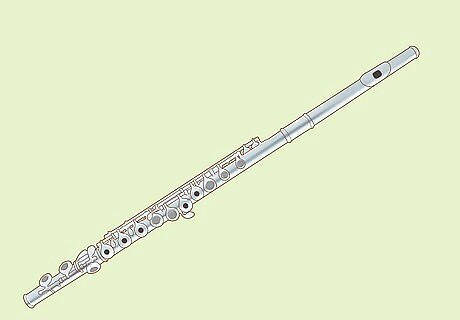
Buy or rent a flute from a music store. Talk to the employees to see which flute is the best for a beginner. If you want to have your own instrument, consider buying the flute. Otherwise, check if the shop offers instrument rentals so you can borrow it when you need it. You can buy a starter flute for around $50 USD, but they may not be the best quality instrument. Many stores have a rent-to-own option where you can pay for your instrument over time.Tip: If you’re still in school, see if they offer instrument rentals for the academic year. That way, you can play in the school band without having to buy your own instrument.

Slide the head joint into the end of your flute. The head joint is the part of your flute with the lip plate and hole where you breathe into the instrument. Take the head joint and the flute’s main body out of the case. Put the head joint into the side of your flute by pushing and twisting it in place. Push the head joint in snugly against the main body. Avoid holding onto any of the rods or keys on the flute’s body while you’re putting your flute together since they could easily get damaged.
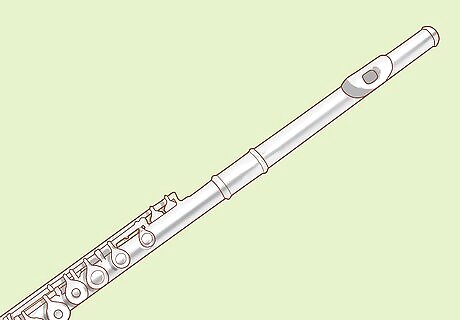
Line up the hole in the head joint with the first key on the flute. Locate the first key on the main body of your flute. Twist the head joint so the mouth hole is in line with the key. Hold the flute up at eye level and look down the body to make sure the hole is perfectly aligned. If the hole is too far forward or backward, it will be more difficult to play your flute with a full tone.
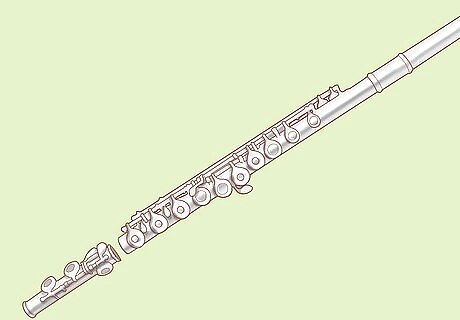
Push the foot joint into place so the metal pin lines up with the keys. The foot joint is the last part of your flute with a few rods and keys on it. Push the foot joint into the bottom end of your flute and twist it in place to secure it. Make sure it has a snug fit against the main body. Rotate the foot joint so the long metal pin running down it lines up with the bottom key on your flute body.
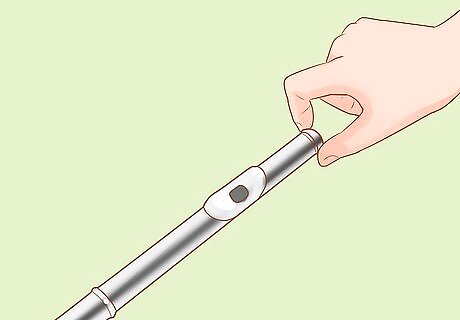
Tune your flute by adjusting the head joint. Use a chromatic tuner or download a tuning app on your phone. Play a note and check if it’s flat or sharp, meaning too low or too high. If the instrument is sharp, twist and pull out the head joint slightly. If your flute is flat, make the instrument shorter by pushing the head joint in further. Adjust the flute until it’s in tune.
Hand and Arm Placement
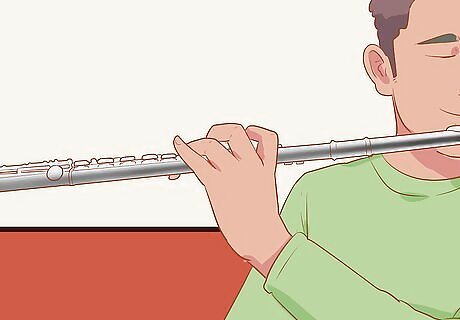
Control the keys closest to the head joint with your left hand. Locate the first key on the bottom of the body of your flute and rest your thumb on it so your palm faces you. Wrap the rest of your fingers around the other side of the flute. Put your index, middle, and ring fingers on the 2nd, 4th, and 5th keys respectively. Rest your pinky on the side key that looks like a paddle. Use the crook of your hand between your thumb and index finger to support the weight of the flute.
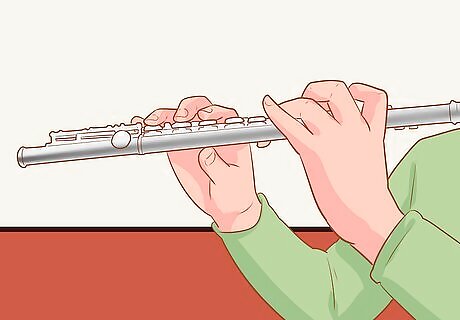
Use your right hand to control the keys at the end of the flute. Use your thumb to support the bottom of the flute. Make sure your palm faces away from you so you can easily press the keys. Locate the bottom 3 keys on the main body of your flute. Put your index, middle, and ring fingers on each of the keys. Use your right pinky to press the first key on the foot joint. Keep your fingers curled so your hands make a C-shape while holding your flute. Don’t press down on the keys immediately. Instead, keep your fingers resting on top of them.Tip: Your fingers will not move to different keys while you play. Never shift your fingers to press different keys or else your fingering will be off for other notes.

Hold the flute parallel to the floor. The end of the flute can point slightly downward. Sit on the edge of a chair so your back is straight and you’re looking ahead. Keep your arms relaxed and away from your body as you raise the flute to your mouth. Make sure the flute is parallel to the ground rather than angling it down. If you want to play your flute standing up, keep your feet shoulder-width apart and firmly planted on the ground.
Proper Embouchure
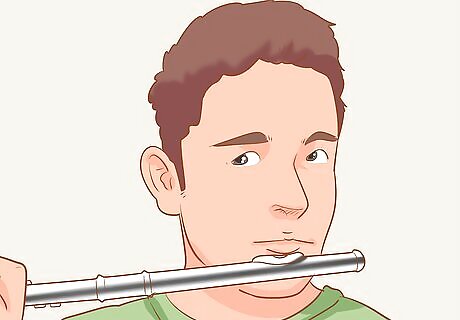
Position the hole underneath the center of your bottom lip. While you’re holding the flute parallel to the floor, set the lip plate underneath your bottom lip. Balance the flute between your chin and bottom lip for the most support. Make sure the hole is directly in the center of your lips to achieve the best tone. If the hole is misaligned, you may not produce a full sound while playing your flute.
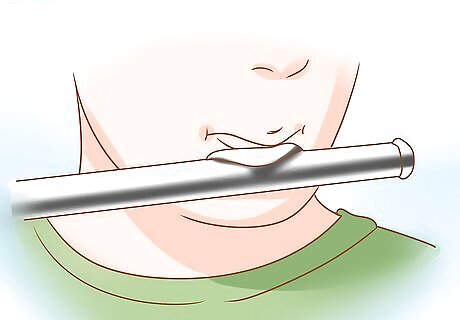
Tighten the corners of your mouth while keeping your lips smooth and relaxed. Firm up the muscles in the corners of your mouth, but not so tightly that your lips are wrinkled or pursed. Pretend that you’re saying the letter “M” to get the right lip posture, or embouchure.Tip: You can practice your embouchure using just the head joint of your flute if you don’t want to use the full instrument right away.
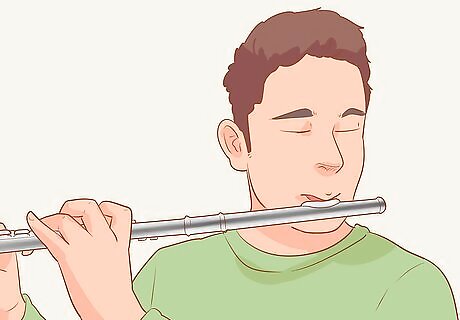
Blow air from the middle of your lips toward the hole. Slightly open your mouth like you’re about to say the letter “P” to blow air into the instrument. Exhale a deep breath in a controlled stream toward the hole to play the flute. The air will travel through the body of the flute and create notes. Don’t open your mouth too wide or else the air won’t travel into the instrument. If you don’t hear any sound coming from the instrument, try slightly pushing your jaw forward or backward to direct the airflow.

Move your tongue back and forth to make short notes. While you’re playing your flute, move your tongue like you’re saying the word “too.” This will help separate the notes you’re playing from one another rather than them sounding like they’re gliding together. Alternate moving your tongue faster and slower to transition between a quick series of short notes and longer, separate notes. These notes are referred to as “staccato.”
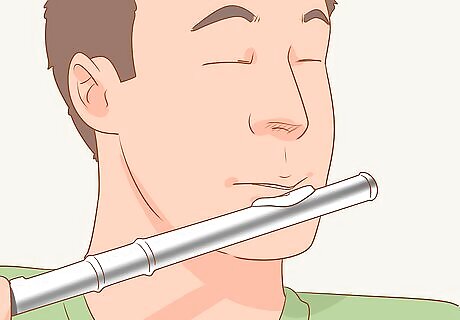
Change the speed of your breath to adjust the pitch of your note. Take a deep breath and exhale slowly across the hole on your flute to hit notes in a lower register. Then with your next breath, tighten the corners of your mouth slightly more and exhale quickly to make a higher-pitched note. Practice alternating between high and low notes so you can develop better range while you play. Make sure your lips stay smooth and unwrinkled or else you may not play with a full tone. When playing high notes, try to aim your airstream upward.
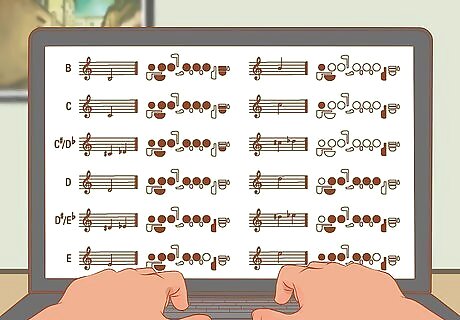
Look at a fingering chart to learn how to play different notes. Fingering charts can help you learn how to play through the notes in a scale. Look for a fingering chart for the type of flute you have so you can see which keys you need to press for each note. Work through each fingering while you play so you can easily change between the notes. Many instructional flute books will come with a fingering chart so you can easily reference them.Tip: Print out a copy of the fingering chart so you can keep it on a music stand while you first learn to play.

















Comments
0 comment